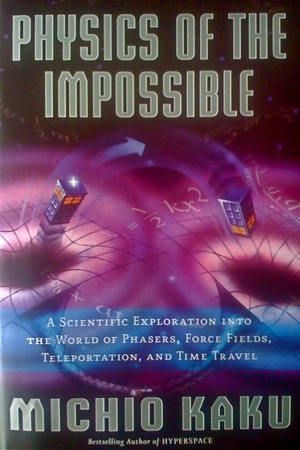
 My kids are inquisitive. My kids like science fiction. My kids ask lots and LOTS of questions: "Can people really travel through wormholes?" or "Could someone really invent a time machine?" or "Who do you think would win in a fight between the Death Star and the Borg?"
My kids are inquisitive. My kids like science fiction. My kids ask lots and LOTS of questions: "Can people really travel through wormholes?" or "Could someone really invent a time machine?" or "Who do you think would win in a fight between the Death Star and the Borg?"
Okay, the last one was mine.
Suffice it to say, they have questions and they are looking to me, being the über-dork of the household, to provide them with answers. I have always felt that serious questions about theoretical sci-fi tech can, and often does, lead to some actual interest in science investigations by my nerd-like offspring. I am not a scientist by trade (although I have played one on stage) so many times my answers to their interrogations came off as, shall we say, a little less than complete… or factual… or in complete sentences.
That is, until now.
Michio Kaku, the Henry Senat Professor of Theoretical Physics at the City University of New York, and an oft filmed physics expert for the Science Channel, has published a new book entitled Physics of the Impossible: A Scientific Exploration into the World of Phasers, Force Fields, Teleportation and Time Travel. This book describes in detail many of the elements that have become commonplace plot devices in science fiction movies and television shows. (There are even some depictions of the TARDIS on the cover!) He uses examples of these technologies, things like cloaking devices, light sabres, warp drive engines, etc., to explain how and when such technology may be developed, and what would be necessary in order to create them.
Kaku divides his subjects into what he calls Classes of Impossibility. Class I impossibilities are things that are not possible today, but that do not violate the laws of physics as we currently understand them. These include things like force fields, invisibility, Phasers and Death Stars, teleportation, telepathy, psychokinesis, extraterrestrials, starships, antimatter power sources and anti-universes. Class II impossibilities are things at the outer limits of our understanding, which may take a millennia or more to develop. Examples of these would include traveling faster than light, time machines and exploring parallel universes. And finally, Class III impossibilities are things like perpetual motion machines and precognition, which appear to violate the known laws of physics.
Physics of the Impossible is written with the sci-fi geek in mind. Most chapters start out with a description of some device from Star Trek, Doctor Who, Star Wars, or the like, and then will go into detail about how such technologies could (or could not) be made to work. It also includes bits of history about how a lot of current technology, things like airplanes, lasers, atomic power, etc., were all considered impossible in the not-too-distant past. This book was written with an adult reader in mind, so unless your kids are high school age or above, I would not recommend it as "light entertainment" for children. However, if you have curious ones in your household like I do in mine, it can be a valuable resource when your own knowledge (or the knowledge you surreptitiously swipe from the Interwebs) falls short of answering those geek queries.
Physics of the Impossible was published in 2008 by Doubleday and is currently available in hard cover from Amazon and other book sellers.

